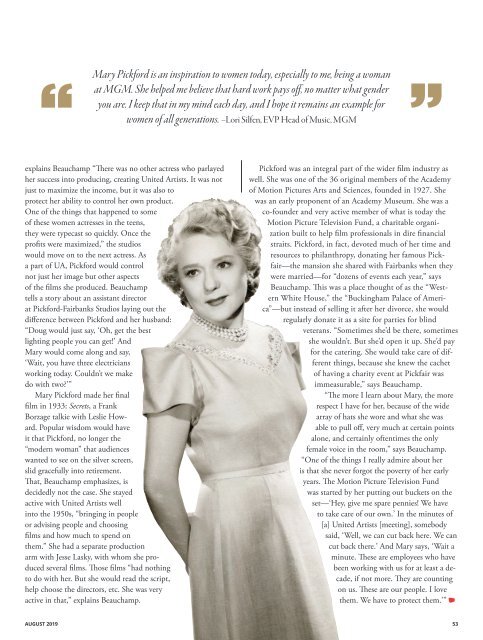Boxoffice - August 2019
The Official Magazine of the National Association of Theatre Owners
The Official Magazine of the National Association of Theatre Owners
You also want an ePaper? Increase the reach of your titles
YUMPU automatically turns print PDFs into web optimized ePapers that Google loves.
Mary Pickford is an inspiration to women today, especially to me, being a woman<br />
at MGM. She helped me believe that hard work pays off, no matter what gender<br />
you are. I keep that in my mind each day, and I hope it remains an example for<br />
women of all generations. –Lori Silfen, EVP Head of Music, MGM<br />
explains Beauchamp “There was no other actress who parlayed<br />
her success into producing, creating United Artists. It was not<br />
just to maximize the income, but it was also to<br />
protect her ability to control her own product.<br />
One of the things that happened to some<br />
of these women actresses in the teens,<br />
they were typecast so quickly. Once the<br />
profits were maximized,” the studios<br />
would move on to the next actress. As<br />
a part of UA, Pickford would control<br />
not just her image but other aspects<br />
of the films she produced. Beauchamp<br />
tells a story about an assistant director<br />
at Pickford-Fairbanks Studios laying out the<br />
difference between Pickford and her husband:<br />
“Doug would just say, ‘Oh, get the best<br />
lighting people you can get!’ And<br />
Mary would come along and say,<br />
‘Wait, you have three electricians<br />
working today. Couldn’t we make<br />
do with two?’”<br />
Mary Pickford made her final<br />
film in 1933: Secrets, a Frank<br />
Borzage talkie with Leslie Howard.<br />
Popular wisdom would have<br />
it that Pickford, no longer the<br />
“modern woman” that audiences<br />
wanted to see on the silver screen,<br />
slid gracefully into retirement.<br />
That, Beauchamp emphasizes, is<br />
decidedly not the case. She stayed<br />
active with United Artists well<br />
into the 1950s, “bringing in people<br />
or advising people and choosing<br />
films and how much to spend on<br />
them.” She had a separate production<br />
arm with Jesse Lasky, with whom she produced<br />
several films. Those films “had nothing<br />
to do with her. But she would read the script,<br />
help choose the directors, etc. She was very<br />
active in that,” explains Beauchamp.<br />
Pickford was an integral part of the wider film industry as<br />
well. She was one of the 36 original members of the Academy<br />
of Motion Pictures Arts and Sciences, founded in 1927. She<br />
was an early proponent of an Academy Museum. She was a<br />
co-founder and very active member of what is today the<br />
Motion Picture Television Fund, a charitable organization<br />
built to help film professionals in dire financial<br />
straits. Pickford, in fact, devoted much of her time and<br />
resources to philanthropy, donating her famous Pickfair—the<br />
mansion she shared with Fairbanks when they<br />
were married—for “dozens of events each year,” says<br />
Beauchamp. This was a place thought of as the “Western<br />
White House,” the “Buckingham Palace of America”—but<br />
instead of selling it after her divorce, she would<br />
regularly donate it as a site for parties for blind<br />
veterans. “Sometimes she’d be there, sometimes<br />
she wouldn’t. But she’d open it up. She’d pay<br />
for the catering. She would take care of different<br />
things, because she knew the cachet<br />
of having a charity event at Pickfair was<br />
immeasurable,” says Beauchamp.<br />
“The more I learn about Mary, the more<br />
respect I have for her, because of the wide<br />
array of hats she wore and what she was<br />
able to pull off, very much at certain points<br />
alone, and certainly oftentimes the only<br />
female voice in the room,” says Beauchamp.<br />
“One of the things I really admire about her<br />
is that she never forgot the poverty of her early<br />
years. The Motion Picture Television Fund<br />
was started by her putting out buckets on the<br />
set—‘Hey, give me spare pennies! We have<br />
to take care of our own.’ In the minutes of<br />
[a] United Artists [meeting], somebody<br />
said, ‘Well, we can cut back here. We can<br />
cut back there.’ And Mary says, ‘Wait a<br />
minute. These are employees who have<br />
been working with us for at least a decade,<br />
if not more. They are counting<br />
on us. These are our people. I love<br />
them. We have to protect them.’”<br />
AUGUST <strong>2019</strong><br />
53

















